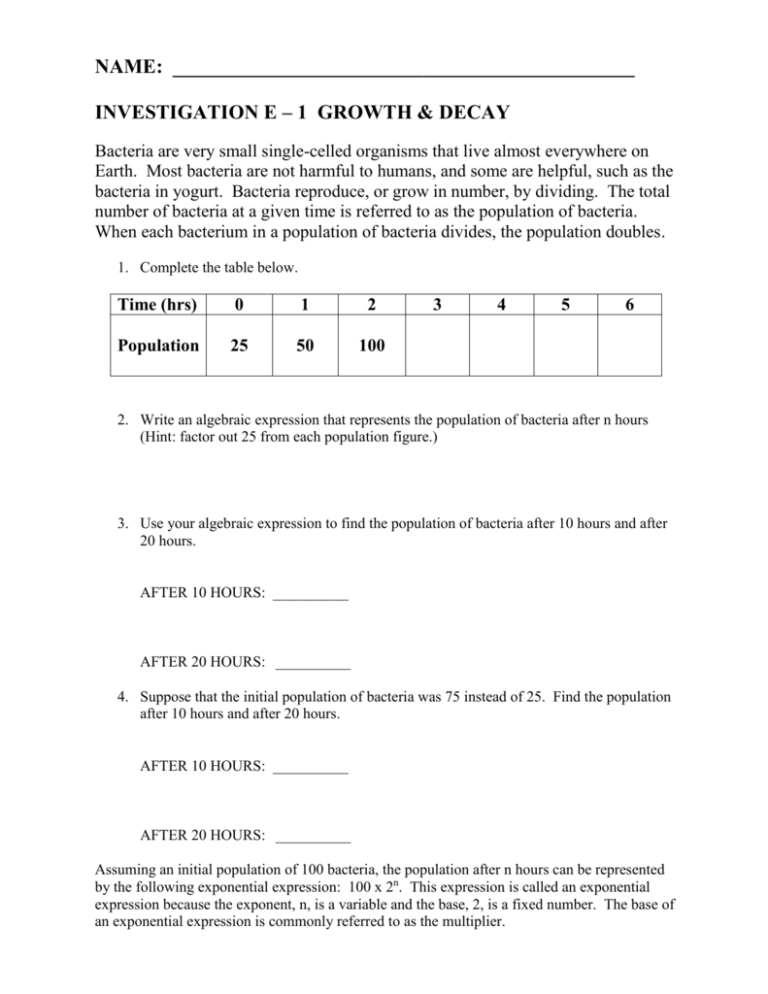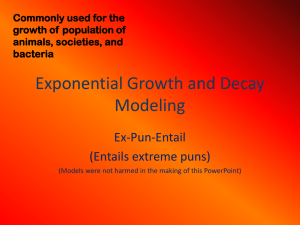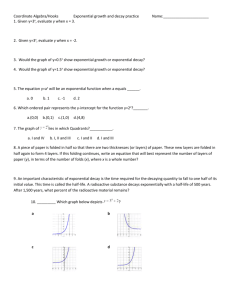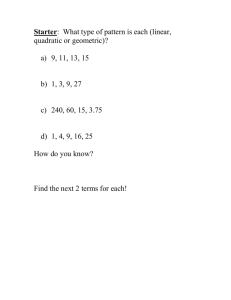investigation e – 1 growth & decay
advertisement

NAME: ______________________________________________ INVESTIGATION E – 1 GROWTH & DECAY Bacteria are very small single-celled organisms that live almost everywhere on Earth. Most bacteria are not harmful to humans, and some are helpful, such as the bacteria in yogurt. Bacteria reproduce, or grow in number, by dividing. The total number of bacteria at a given time is referred to as the population of bacteria. When each bacterium in a population of bacteria divides, the population doubles. 1. Complete the table below. Time (hrs) 0 1 2 Population 25 50 100 3 4 5 6 2. Write an algebraic expression that represents the population of bacteria after n hours (Hint: factor out 25 from each population figure.) 3. Use your algebraic expression to find the population of bacteria after 10 hours and after 20 hours. AFTER 10 HOURS: __________ AFTER 20 HOURS: __________ 4. Suppose that the initial population of bacteria was 75 instead of 25. Find the population after 10 hours and after 20 hours. AFTER 10 HOURS: __________ AFTER 20 HOURS: __________ Assuming an initial population of 100 bacteria, the population after n hours can be represented by the following exponential expression: 100 x 2n. This expression is called an exponential expression because the exponent, n, is a variable and the base, 2, is a fixed number. The base of an exponential expression is commonly referred to as the multiplier. Human populations grow much more slowly than bacterial populations. Basterial populations that double each hours have a growth rate of 100% per hour (multiplier = 1 + 1 = 2, n = # hours). The population of the United States in 1990 was growing at a rate of about 8% per decade ( multiplier = 1 + .08 = 1.08, n = # decades). 5. The population of Brazil was about 162,661,000 in 1996 and was projected to grow at a rate of about 7.7% per decade. Predict the population, to the nearest hundred thousand, of Brazil for 2016 and 2020. MULTIPLIER: __________ EXPONENTIAL EXPRESSION: ___________________________________ POPULATION in 2016: __________ POPULATION IN 2020: __________ A rate of decay can be though of as a negative growth rate. To obtain the multiplier for a decay, subtract the rate of decay from 100% (1). Example: Caffeine is eliminated from the bloodstream of a child at a rate of about 25% per hour. To obtain the multiplier for the decrease in caffeine in the bloodstream of a child, subtract the rate of decay, 25% (.25), from 100% (1). Thus the multiplier is 0.75. 6. A vitamin is eliminated from the bloodstream at a rate of about 20% per hour. The vitamin reaches a peak level in the bloodstream of 300 milligrams. Predict the amount, to the nearest tenth of a milligram, of the vitamin remaining 2 hours after the peak level and 7 hours after the peak level. MULTIPLIER: __________ EXPONENTIAL EXPRESSION: ___________________________________ AMOUNT REMAINING AFTER 2 HOURS: __________ AMOUNT REMAINING AFTER 7 HOURS: __________









